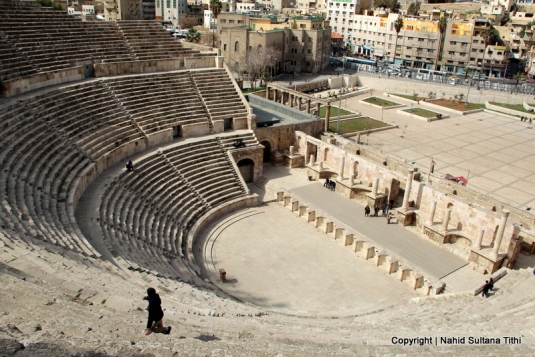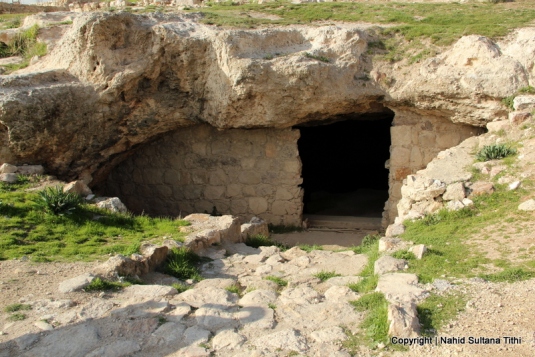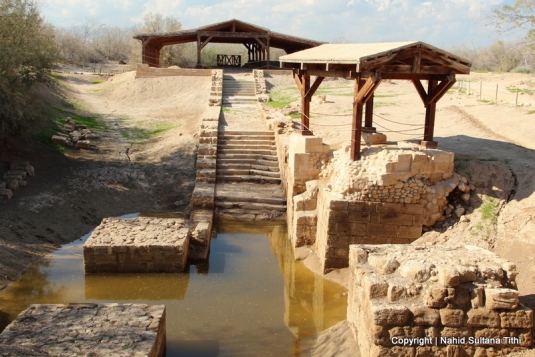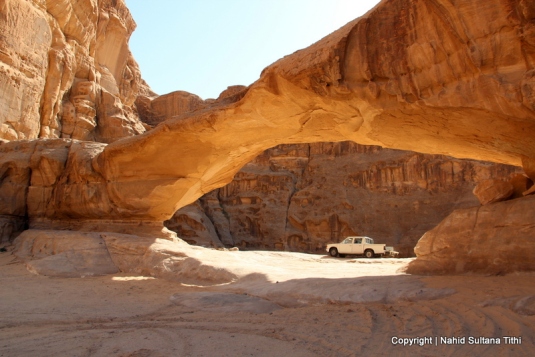Journey Around The Globe
ready for the next destination
Amman and Back
AMMAN, JORDAN: Guess what was the ancient name of Jordan’s capital Amman? Philadelphia…sounds weird, but this city, once used to be known as Philadelphia, dates back to some 7000 years, as some estimate. Old Amman is situated mostly on hilly areas and built of white stone. The city has witnessed many ages, dynasties, and rulers, starting from pottery Neolithic from 5500 BC to Bronze and Iron ages, to Persian and Hellenistic, then Roman and Byzantine. Then finally by Muslim dynasties like Umayyad, Fatimid, Mamluk, and Ottoman. Currently the King of Hashemite Kingdom of Jordan (country’s formal name) Abdul Aziz and his officials have built the country to be one of the most developed in the Middle-East while keeping the heritage of thousands of years of history. Interesting fact about the king is that King Abdul Aziz is from Bedouin family, therefore the Jordanian Bedouins are a bit well-off. They get about few hundreds JD per month from the gov’t and can live in any mountains or deserts outside of city boundaries.
The old town of Amman is situated on few small hills. Don’t hesitate to ask help from the local…they are very friendly and will try their best to help you even if they don’t speak good English.
You can get visa to enter Jordan right at their airport for 20 JD per person and the airport is about half an hour drive from the old city center of Amman.
TIME of TRAVEL: We flew to Amman from Tervuren on 3rd week of February, 2013. It was nice and pleasant during the day but chilly at night. May be carrying a sweater is not a bad idea if you are traveling around this time of the year.
OUR HOTEL: Our hotel in Amman, Arab Tower Hotel, was a very nice and clean place with friendly staffs. The hotel offers free breakfast but didn’t have in-room Wi-Fi (although it was mentioned when we were booking through Hotel.com). The hotel is located in the heart of Old Amman surrounded by any shops and busy streets. We could actually both Citadel and Roman Theater from our 6th floor window.
EATING and SHOPPING: Eat at Anwar Makkah in the old city center…seems like almost every local know about this restaurant. This is more like a street-side cheap place for traditional food like kebab, bread, salad, and Jordanian style rice.
There are many souks and souvenir shops in the Old Amman. Never jump to buy something you like without bargaining. Sand art in bottles are very popular here, as well as decorative wall hangings and tea accessories. Kuffiyeh, the checkered scarves, are good to blend yourself in with the locals and protect you from sun too.
PLACES WE’VE VISITED: We literary spent about 5 hours in Old Town Amman and as many others have suggested, it’s more than enough to explore the city. The main beauty of Jordan is not in the city, rather in the deserts and mountains. That’s why we ended up taking few day-trips here and there to maximize the fun.
1) ROMAN AMPHITHEATER: The amphitheater was built by the Roman Emperor in 138-161 AD and until today it has been the largest theater in Jordan. Ruins of some Roman-style columns near the ticket office are also part of its beauty. With the capacity of 6000 spectators, this is an important archaeological monument of the ancient Roman. It is still used today for artistic performances. View of the fortification walls of citadel in front and the white stone buildings on the hills are magnificent from the top stairs of the theater.
Jordanian Museum of Popular Tradition inside the amphitheater is worth spending 10-15 minutes to see traditional clothes/thobes from different villages or regions of Jordan and Palestine. Other than some jewelries, pots, gadgets, ancient mosaics discovered from 6th century (mainly from Jarash or Madaba) are worth looking at. There is also a smaller amphitheater right outside the main gate of the big one and can be covered using the same ticket.
It shouldn’t take more than 45 minutes to visit the museum and go on top of the amphitheater. 1 JD entrance fee per person above 15 yrs. of age and covers the main amphitheater, the museum inside it, and the smaller theater close to the main one. This is open from 8-4 pm for the visitors.
2) CITADEL: Situated up on top of one of the city’s high hills, this is a National Historic site and one of Amman’s oldest known places. It’s known as Jabal al Qala’a to the locals. This has been used as a settlement and a fortress for thousands of years. This is an astounding open-air museum where visitors can walk through time and see the relics of numerous civilizations. Within the fortification wall of the Citadel, you can see the cave from Early Bronze Age, signature columns and temple of Romans, then ruins from Umayyad dynasty. It seems the local authority takes good care of this place. It’s not only clean and organized but also very well-marked with information board at each corner. Located on a mountain, it gives visitors a perspective of the city’s incredible history and also provides stunning views of the entire area. We couldn’t stay until the sunset but I am assuming it should be a great experience from this elevation.
Some of the highlights of this place are Roman Temple of Hercules, Early Bronze Age cave, Byzantine Church, Umayyad Mosque, Umayyad residential units, and Umayyad Palace. The cave that I’ve mentioned dates back to the 23rd century BC. This cave houses a series of rock-cut tombs which was later used as a place to prepare the stones to build the massive Citadel. Umayyad Mosque and the residential units are now in complete ruins, nothing but few columns and walls still stand to give you an idea of their existence.
The Citadel is open from 8 – 6 pm during the summer season and 8 – 4 pm during winter. 2 JD is per person is the entrance fee (kids <15 yrs. are free) just for the citadel itself, but you want to visit the museum inside it, then the ticket is 5 JD. To ascend to Citadel, you can either take the stairs (takes about 10/15 minutes) or an easier option is to just a taxi (about 2 JD from bottom of the hill).
3) DAY TRIP to MADABA, MT. NEBO, BETHANY, and DEAD SEA: This can be a great day-trip from Amman if you are interested in the history of Islam, Christianity, and Judaism. Madaba is famous for its ancient mosaic work which can still be seen from the 6th century AD. Mt. Nebo is where Moses was granted to view the “Promised Land” from and where he died and was buried. Bethany is a sacred place for Christians since this is the place where Christ was baptized by John the Baptist. Finally, Dead Sea is earth’s lowest point and the largest land-locked salty body of water in the world. Please visit my page on the right-hand side for detailed information and pictures from this trip.
4) DAY TRIP to ASHABUL KAHF, AJLOUN, and JARASH: This was another fantastic day trip which was not in our itinerary but our guide advised it. Ashabul Kahf is a historic cave for the Muslims where 7 boys and their dog slept for hundreds of years and this event was mentioned in the Qur’an under Surah Kahf. Ajloun is a city about 120 km north of Amman. Other than the scenic drive to Ajloun, there is a Castle made by the mighty Salahdin’s General in 1184, called Ajloun Castle. There is also a church on the mountain, Our Lady of Virgin Mary, which was built right beside the cave where Jesus, Mary, and his disciples stayed for a short time while passing by this city. Finally, Jarash is a city which had a big Roman settlement in the early 1st and 2nd century. This is known to be one of the best preserved Roman provincial towns in the world. The whole city, including its few gates, churches, amphitheaters, main street take you back in the time of the Romans. I can compare it to the Roma Forum in Rome, except the ruins in Jarash are more well-maintained and taken care off. Please visit my separate page on this day trip for full information and to see the pictures.
5) DAY TRIP to MUJIB, KARAK, DANA, and SHOBAK: We took this trip on our way to Petra. King’s Way is a beautiful scenic route from Amman to Petra and these 4 small towns fall on this long stretch of road. Wadi Mujib or Valley Mujib has a dam called Dam Al Mujib. We stopped here only for 15-20 minutes to see the valley and canyon created by the monstrous mountains. Dana was also was just a view-point from top of a mountain. Karak has an old crusaders’ castle called Karak Castle on a hill-top which was later occupied by Salahdin around 12th century. Shobak also has some ruins of a smaller castle, called Shobak Castle. This was also built by the crusaders somewhere around 11th or 12th century. Please visit my page on the right-hand side for more detailed information and pictures.
6) TRIP to PETRA: Trip to Jordan won’t be half as excited without visiting Petra. Petra is like a totally different world and in different time setting. You can’t picture the grandness of Petra without physically experiencing it. This place gives you a scenic view of Wadi Musa (Valley of Moses) as well as glimpse of the ancient Nabataean civilization from the 6th century BC.
7) DAY TRIP to WADI RUM: This was probably the 2nd best day-trip that we took in Jordan after Petra. To actually go into the heart of a desert is a timeless experience, especially with a Bedouin in his 4×4 jeep. Wadi Rum means “Valley of the Moon” and the terrain here does look like the surface of the moon with many small mountains, fascinating rock-formations, and white sand-dunes. Finally, can’t beat the experience of having Bedouin cooked lunch out in the valley. Wadi Rum is also popular for overnight camping to get up close and personal with the Bedouins.
Related articles
- Touchdown in Amman, Jordan (mustudyabroad.wordpress.com)
- Jordan Sees New Surge in Syrians Fleeing Civil War (world.time.com)














Pingback: International Conference on Transgenerational Trauma
Pingback: Wadi Rum, Jordan – Journey to the moon | Journey Around The Globe
Pingback: The Rose-Red City of Petra, Jordan | Journey Around The Globe
Pingback: Vacation Inspiration: 4 weeks backpacking in the Middle East | SbsInMoneyCome.com
Pingback: Jordan Trip 2013 – Wadi Mujib, Karak, Dana, and Shobak | Journey Around The Globe
Pingback: Jordan Trip 2013 – Day Trip to Ashabul Kahf, Ajloun, and Jarash | Journey Around The Globe
Pingback: Poverty in the kingdom of Jordan | Dear Kitty. Some blog
Pingback: Jordan 2013 – Day trip to Madaba, Mt. Nebo, Bethany, and Dead Sea | Journey Around The Globe
What a fantastic trip! The Roman amphitheater and city really caught my eye because of their age, I believe. How wonderful to still have something from that long ago still be usable today. Thanks for stopping by!
LikeLike
Thanks for your visit Bev, always a pleasure to read your comments.
LikeLike
Fabulous! Petra is in my Bucket List. So glad to hear its worth the journey.
LikeLike
It’s worth every penny visiting Petra, it won’t disappoint you. Thanks for your visit
LikeLike